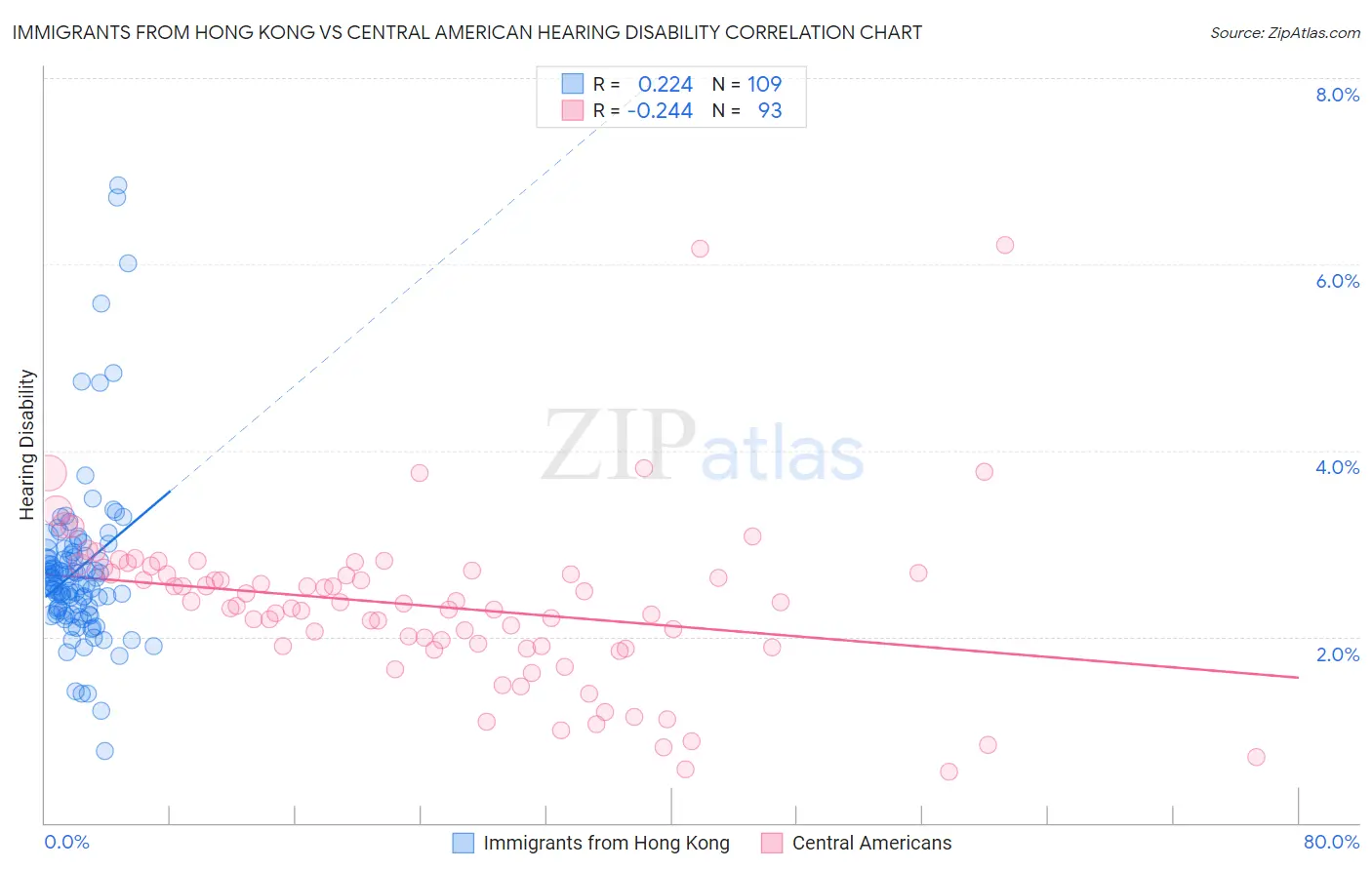Immigrants from Hong Kong vs Central American Hearing Disability
COMPARE
Immigrants from Hong Kong
Central American
Hearing Disability
Hearing Disability Comparison
Immigrants from Hong Kong
Central Americans
2.7%
HEARING DISABILITY
99.2/ 100
METRIC RATING
51st/ 347
METRIC RANK
2.7%
HEARING DISABILITY
97.7/ 100
METRIC RATING
71st/ 347
METRIC RANK
Immigrants from Hong Kong vs Central American Hearing Disability Correlation Chart
The statistical analysis conducted on geographies consisting of 253,945,747 people shows a weak positive correlation between the proportion of Immigrants from Hong Kong and percentage of population with hearing disability in the United States with a correlation coefficient (R) of 0.224 and weighted average of 2.7%. Similarly, the statistical analysis conducted on geographies consisting of 504,204,845 people shows a weak negative correlation between the proportion of Central Americans and percentage of population with hearing disability in the United States with a correlation coefficient (R) of -0.244 and weighted average of 2.7%, a difference of 2.7%.

Hearing Disability Correlation Summary
| Measurement | Immigrants from Hong Kong | Central American |
| Minimum | 0.77% | 0.55% |
| Maximum | 6.9% | 6.2% |
| Range | 6.1% | 5.7% |
| Mean | 2.7% | 2.3% |
| Median | 2.6% | 2.4% |
| Interquartile 25% (IQ1) | 2.3% | 1.9% |
| Interquartile 75% (IQ3) | 2.9% | 2.7% |
| Interquartile Range (IQR) | 0.63% | 0.81% |
| Standard Deviation (Sample) | 0.93% | 0.91% |
| Standard Deviation (Population) | 0.92% | 0.91% |
Demographics Similar to Immigrants from Hong Kong and Central Americans by Hearing Disability
In terms of hearing disability, the demographic groups most similar to Immigrants from Hong Kong are Jamaican (2.7%, a difference of 0.36%), Immigrants from Eastern Asia (2.7%, a difference of 0.42%), Ethiopian (2.7%, a difference of 0.46%), Immigrants from Ethiopia (2.7%, a difference of 0.52%), and Immigrants from Nicaragua (2.7%, a difference of 0.54%). Similarly, the demographic groups most similar to Central Americans are Peruvian (2.7%, a difference of 0.050%), Nicaraguan (2.7%, a difference of 0.28%), Immigrants from Africa (2.7%, a difference of 0.32%), Egyptian (2.7%, a difference of 0.45%), and Immigrants from Belize (2.7%, a difference of 0.68%).
| Demographics | Rating | Rank | Hearing Disability |
| Immigrants | Hong Kong | 99.2 /100 | #51 | Exceptional 2.7% |
| Jamaicans | 99.0 /100 | #52 | Exceptional 2.7% |
| Immigrants | Eastern Asia | 99.0 /100 | #53 | Exceptional 2.7% |
| Ethiopians | 99.0 /100 | #54 | Exceptional 2.7% |
| Immigrants | Ethiopia | 99.0 /100 | #55 | Exceptional 2.7% |
| Immigrants | Nicaragua | 99.0 /100 | #56 | Exceptional 2.7% |
| South Americans | 99.0 /100 | #57 | Exceptional 2.7% |
| Immigrants | Peru | 98.6 /100 | #58 | Exceptional 2.7% |
| Immigrants | Eritrea | 98.5 /100 | #59 | Exceptional 2.7% |
| Immigrants | Egypt | 98.5 /100 | #60 | Exceptional 2.7% |
| Immigrants | Uzbekistan | 98.4 /100 | #61 | Exceptional 2.7% |
| Immigrants | Colombia | 98.4 /100 | #62 | Exceptional 2.7% |
| Indians (Asian) | 98.4 /100 | #63 | Exceptional 2.7% |
| Immigrants | Sri Lanka | 98.4 /100 | #64 | Exceptional 2.7% |
| Immigrants | Nepal | 98.3 /100 | #65 | Exceptional 2.7% |
| Immigrants | Belize | 98.2 /100 | #66 | Exceptional 2.7% |
| Egyptians | 98.1 /100 | #67 | Exceptional 2.7% |
| Immigrants | Africa | 98.0 /100 | #68 | Exceptional 2.7% |
| Nicaraguans | 97.9 /100 | #69 | Exceptional 2.7% |
| Peruvians | 97.7 /100 | #70 | Exceptional 2.7% |
| Central Americans | 97.7 /100 | #71 | Exceptional 2.7% |